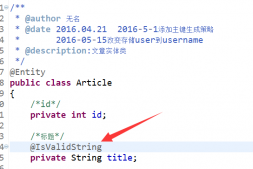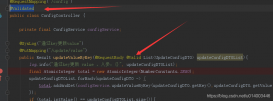本文实例为大家分享了java实现图形卡片排序游戏的具体代码,供大家参考,具体内容如下
掌握类的继承、多态性使用方法以及接口的应用。
输入格式:
首先,在一行上输入一串数字(1~4,整数),其中,1代表圆形卡片,2代表矩形卡片,3代表三角形卡片,4代表梯形卡片。各数字之间以一个或多个空格分隔,以“0”结束。例如: 1 3 4 2 1 3 4 2 1 3 0
然后根据第一行数字所代表的卡片图形类型,依次输入各图形的相关参数,例如:圆形卡片需要输入圆的半径,矩形卡片需要输入矩形的宽和长,三角形卡片需要输入三角形的三条边长,梯形需要输入梯形的上底、下底以及高。各数据之间用一个或多个空格分隔。
输出格式:
如果图形数量非法(小于0)或图形属性值非法(数值小于0以及三角形三边不能组成三角形),则输出Wrong Format。
如果输入合法,则正常输出,所有数值计算后均保留小数点后两位即可。输出内容如下:
排序前的各图形类型及面积,格式为图形名称1:面积值1图形名称2:面积值2 …图形名称n:面积值n,注意,各图形输出之间用空格分开,且输出最后存在一个用于分隔的空格;
排序后的各图形类型及面积,格式同排序前的输出;
所有图形的面积总和,格式为Sum of area:总面积值。
输入样例1:
在这里给出一组输入。例如:
1 5 3 2 0
输出样例1:
在这里给出相应的输出。例如:
Wrong Format
输入样例2:
在这里给出一组输入。例如:
4 2 1 3 0
3.2 2.5 0.4 2.3 1.4 5.6 2.3 4.2 3.5
输出样例2:
在这里给出相应的输出。例如:
The original list:
Trapezoid:1.14 Rectangle:3.22 Circle:98.52 Triangle:4.02
The sorted list:
Circle:98.52 Triangle:4.02 Rectangle:3.22 Trapezoid:1.14
Sum of area:106.91
输入样例3:
在这里给出一组输入。例如:
4 2 1 3 0
3.2 2.5 0.4 2.3 1.4 5.6 2.3 4.2 8.4
输出样例3:
在这里给出相应的输出。例如:
Wrong Format
参考代码如下:
|
1
2
3
4
5
6
7
8
9
10
11
12
13
14
15
16
17
18
19
20
21
22
23
24
25
26
27
28
29
30
31
32
33
34
35
36
37
38
39
40
41
42
43
44
45
46
47
48
49
50
51
52
53
54
55
56
57
58
59
60
61
62
63
64
65
66
67
68
69
70
71
72
73
74
75
76
77
78
79
80
81
82
83
84
85
86
87
88
89
90
91
92
93
94
95
96
97
98
99
100
101
102
103
104
105
106
107
108
109
110
111
112
113
114
115
116
117
118
119
120
121
122
123
124
125
126
127
128
129
130
131
132
133
134
135
136
137
138
139
140
141
142
143
144
145
146
147
148
149
150
151
152
153
154
155
156
157
158
159
160
161
162
163
164
165
166
167
168
169
170
171
172
173
174
175
176
177
178
179
180
181
182
183
184
185
186
187
188
189
190
191
192
193
194
195
196
197
198
199
200
201
202
203
204
205
206
207
208
209
210
211
212
213
214
215
216
217
218
|
import java.util.ArrayList;import java.util.Collections;import java.util.Scanner;public class Main { //在Main类中定义一个静态Scanner对象,这样在其它类中如果想要使用该对象进行输入,则直接 //使用Main.input.next…即可(避免采坑) public static Scanner input = new Scanner(System.in); public static void main(String[] args){ ArrayList<Integer> list = new ArrayList<Integer>(); int num = input.nextInt(); while(num != 0){ if(num < 0 || num > 4){ System.out.println("Wrong Format"); System.exit(0); } list.add(num); num = input.nextInt(); } DealCardList dealCardList = new DealCardList(list); if(!dealCardList.validate()){ System.out.println("Wrong Format"); System.exit(0); } dealCardList.showResult(); input.close(); } }class Card{ Shape shape; Card(){ } Card(Shape shape){ this.shape=shape; } public Shape getShape() { return shape; } public void setShape(Shape Shape) { this.shape=shape; } }class DealCardList{ ArrayList<Card> cardList=new ArrayList<Card>(); DealCardList(){ } DealCardList(ArrayList<Integer> list){ for(int i=0;i<list.size();i++) { if(list.get(i)==1) { double r=Main.input.nextDouble(); Circle circle=new Circle(r); Card card=new Card(circle); card.getShape().setShapeName("Circle"); cardList.add(card); } if(list.get(i)==2) { double a=Main.input.nextDouble(); double b=Main.input.nextDouble(); Rectangle rectangle=new Rectangle(a,b); Card card=new Card(rectangle); card.getShape().setShapeName("Rectangle"); cardList.add(card); } if(list.get(i)==3) { double a=Main.input.nextDouble(); double b=Main.input.nextDouble(); double c=Main.input.nextDouble(); Triangle triangle=new Triangle(a,b,c); Card card=new Card(triangle); card.getShape().setShapeName("Triangle"); cardList.add(card); } if(list.get(i)==4) { double a=Main.input.nextDouble(); double b=Main.input.nextDouble(); double c=Main.input.nextDouble(); Traperoid traperoid=new Traperoid(a,b,c); Card card=new Card(traperoid); card.getShape().setShapeName("Trapezoid"); cardList.add(card); } } } public boolean validate() { for(int i=0;i<cardList.size();i++) {if(!cardList.get(i).getShape().vaildate()) return false;} return true; } public void cardSort() { for(int k=0;k<cardList.size();k++) for(int i=k+1;i<cardList.size();i++) { if(cardList.get(k).getShape().getArea()<cardList.get(i).getShape().getArea()) Collections.swap(cardList, k, i); } } public double getAllArea() { double s=0; for(int i=0;i<cardList.size();i++) s=s+cardList.get(i).getShape().getArea(); return s; } public void showResult() { System.out.println("The original list:"); for(int i=0;i<cardList.size();i++) System.out.print(cardList.get(i).getShape().getShapeName()+":"+String.format("%.2f",cardList.get(i).getShape().getArea())+" "); System.out.println(); System.out.println("The sorted list:"); cardSort(); for(int i=0;i<cardList.size();i++) System.out.print(cardList.get(i).getShape().getShapeName()+":"+String.format("%.2f",cardList.get(i).getShape().getArea())+" "); System.out.println(); System.out.println("Sum of area:"+String.format("%.2f",getAllArea())); }} class Shape { private String shapeName; Shape(){ } Shape(String shapeName){ this.shapeName=shapeName; } public String getShapeName() { return shapeName; } public void setShapeName(String shapeName) { this.shapeName=shapeName; } public double getArea() { return 0.0; } public boolean vaildate() { return true; } }class Circle extends Shape{ private double radius; Circle(){ } Circle(double radius){ this.radius=radius; } public double getArea() { return Math.PI*radius*radius; } public boolean vaildate() { if(radius>0) return true; else return false; }}class Rectangle extends Shape{ private double width,length; Rectangle (double width,double length){ this.width=width; this.length=length; } public double getArea() { return width*length; } public boolean vaildate() { if(width>0&&length>0) return true; else return false; } }class Triangle extends Shape{ double side1,side2,side3; Triangle(double side1,double side2,double side3){ this.side1=side1; this.side2=side2; this.side3=side3; } public double getArea() { double c=(side1+side2+side3)/2; double s=Math.sqrt(c*(c-side1)*(c-side2)*(c-side3)); return s; } public boolean vaildate() { if(side1+side2>side3&&side1+side3>side2&&side2+side3>side1) return true; else return false; } }class Traperoid extends Shape{ private double topSide,bottomSide,height; Traperoid(){ } Traperoid(double topSide,double bottomSide,double height){ this.bottomSide=bottomSide; this.height=height; this.topSide=topSide; } public double getArea() { return (topSide+bottomSide)*height/2; } public boolean validate() { if(topSide>0&&bottomSide>0&&height>0) return true; else return false; }} |
以上就是本文的全部内容,希望对大家的学习有所帮助,也希望大家多多支持服务器之家。
原文链接:https://blog.csdn.net/qq_45028587/article/details/107419481















